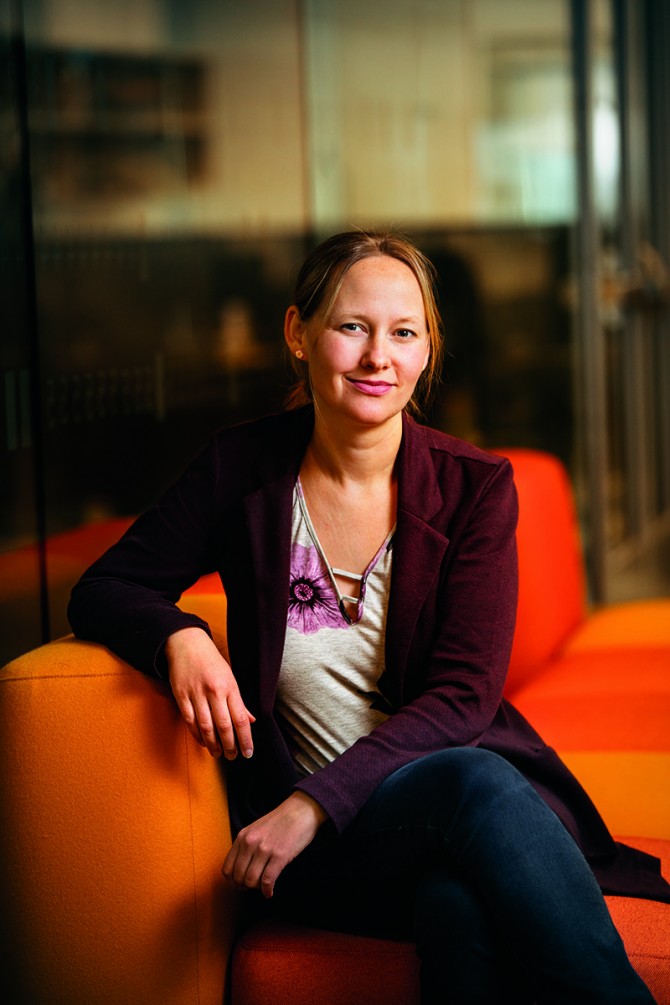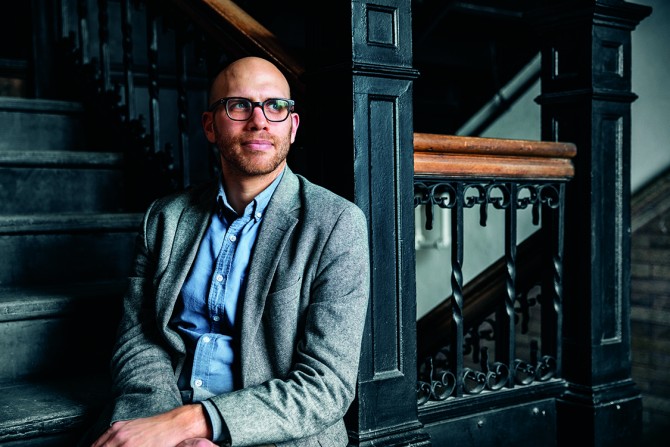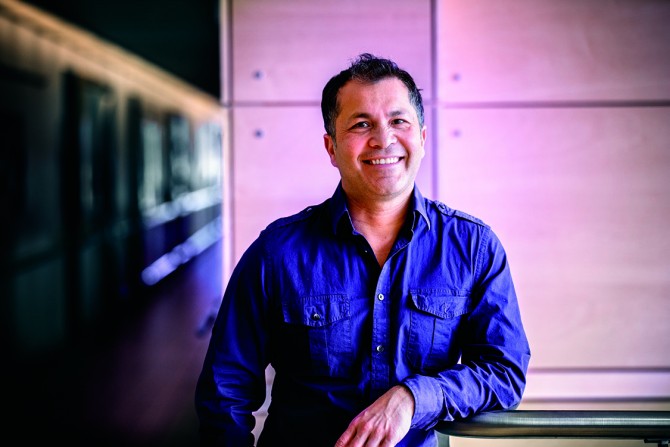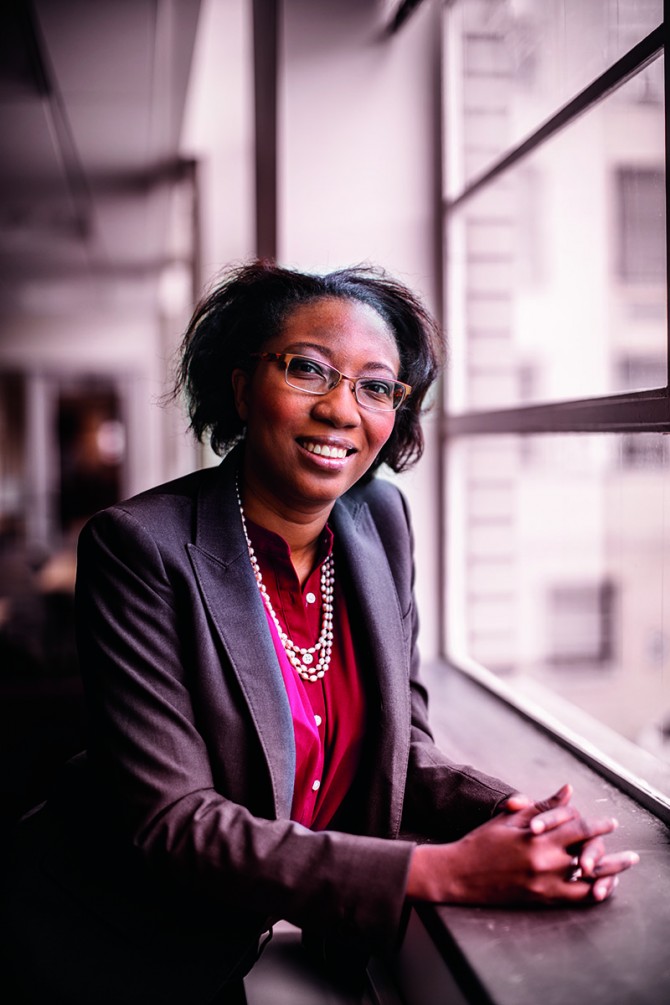Faculty Profiles: Spring 2018
Kirstin Petersen: Engineering robot collectives that mimic social insects
When you first step inside the Collective Embodied Intelligence Lab at Cornell, you might not guess you’ve entered a robotics laboratory.
An empty termite nest and beehive are stationed in a display case near the entrance. A preserved bee sits lifeless inside a small glass jar on a table. A chunk of wood is being devoured by live termites in the back of the laboratory as a small colony of ants diligently digs through an encasement.
The lab is run by Kirstin Petersen, assistant professor of electrical and computer engineering, who designs tools that can analyze and learn from social insects, and then uses that knowledge to build robots that work in similar ways.
“If you look at ants and bees and termites in nature, for instance, you see that they’re capable of remarkably complex behavior like foraging, nest construction, defense,” explains Petersen, “and we can build robot collectives like them … that are capable of achieving tasks in a manner that’s more efficient and error tolerant than traditional robot systems.”
Petersen drew inspiration for such a robot collective after observing an African species of mound-building termite while in Namibia. By combining 3-D scanners with software to automatically track and label the insects, she was able to continuously observe their behavior and collect data.
That data was used to code a system in which large numbers of robots could build human-scale structures using some of the same collaborative principles observed in the termites.
A more recent project of Petersen’s aims to develop submillimeter flight recorders that can be attached to honeybees. The goal of the project is to map foraging patterns to learn more about the insects’ pollination habits, as well as to extract data that could analyze the health of crops.
“It is incredibly exciting to see robots becoming more and more commonplace in our daily lives,” she says. “Soon we may see large collectives of robots working alongside human and biological teams to solve complex tasks in the real world.”
– Syl Kacapyr
Nicholas Klein: Transportation planning as social mobility
“I am passionate about transportation planning,” says Nicholas J. Klein ’01, assistant professor in the Department of City and Regional Planning in the College of Architecture, Art and Planning. “Not so much the things of transportation – like buses, cars and transit systems – but the people who use them.”
In his research and teaching, Klein examines the ways that transportation is both an influencer and marker of economic outcomes in people’s lives. He studies how transportation options affect people over time, in terms of individual lifetimes and generationally, with particular attention to how life events play a role.
Klein’s quantitative research has looked closely at both car ownership and access to public transportation as tools for social, economic and physical mobility.
For example, while there are some neighborhoods with great public transportation where families without cars can achieve the same outcomes as families with cars, unfortunately that is not the case for neighborhoods in most of the country. In most places, access to a car is more likely to lead to gaining a job and moving up the economic ladder as well as shorter commutes. Making and keeping health care appointments is easier, and access to other enrichments is increased.
“The policy solutions are not so clear,” says Klein. “How can transportation planning be used as a social mobility tool? That is the real question.”
In addition to a bachelor’s degree in operations research and industrial engineering from Cornell in 2001, Klein received a master’s degree in urban spatial analytics from the University of Pennsylvania and a Ph.D. from Rutgers University. Hired in July 2017, Klein says he was pleased to return to Cornell after teaching at Columbia University, Temple University and Pratt Institute.
“The students here ... come to the university with a genuine interest in urban issues, problems, and how they can develop solutions,” Klein says. He looks forward to engaging with collaborators across the university, particularly in engineering and civil engineering, where there are opportunities for overlap in the area of urban planning and transportation.
– Patti Witten
Hector Aguilar-Carreno: The microscopic fight against a deadly trojan horse
As an 8-year-old growing up in Tepic, Nayarit, Mexico, Hector Aguilar-Carreno watched the climbing tendrils of a squash plant and measured how fast the tendril circled around a neighboring twig. “I wanted to know how the plant shoot knew which way to go – and realized there must be a way for the plant to sense the twig,” he says. “It got me thinking more microscopically.”
Aguilar-Carreno joined the College of Veterinary Medicine as an associate professor in July 2017. “Cornell is a place where we can do great things in the field of virology,” he says. “It’s the one of the best environments in the country – and in the world.”
His research interests have expanded from squash tendrils to understanding the behavior of some of the most mysterious and deadly viruses in the world – how they fuse with, enter and replicate in host cells. Aguilar-Carreno studies members of the Paramyxoviridae family, including the Nipah and Hendra viruses, which are carried by bats and can pass easily across the animal kingdom, killing most of their human hosts.
“A tiny piece of genetic material can overtake an entire complex animal,” he says.
These viruses are known as envelope viruses, so-called because they cloak themselves in the membranes of their host cells like a microscopic Trojan horse, making them relatively less visible to the host’s immune system. Aguilar-Carreno describes blocking membrane fusion as his research holy grail, and his lab is working to uncover more viral and cellular proteins that can play a key role.
Although blocking membrane fusion in the body is tricky, it’s clear Aguilar-Carreno has the tenacity to see these efforts through. “I am a very determined person,” he says. “If we’re able to find broad antivirals that can target these enveloped viruses, we will solve so many problems. It would dramatically improve both veterinary and human health.”
– Melanie Greaver Cordova
Ludmilla Aristilde: Transformative scientist
Humans have long understood the general concept of natural carbon recycling: when animal and plant wastes are applied to farm fields, the soil is more productive. Yet the underlying chemistry of that process – how natural organics are trapped, transported and cycled through plants and soils – is still largely a mystery.
Ludmilla Aristilde ’03 plans to solve it. An assistant professor of biological and environmental engineering in the College of Agriculture and Life Sciences, Aristilde works at the interface of natural and engineering systems. She seeks to understand how organic contaminants affect sensitive ecosystems, how organic chemicals are secreted by plants and microbes, how these organics are transformed into useful plant nutrients or harmful greenhouse gases, and how natural and contaminant organics move in the environment.
With a better understanding of these processes, engineers could develop technologies that trap and recycle organic waste more effectively and reduce the need for synthetic chemicals, including fertilizers. Her work has implications for problems ranging from water pollution to ecosystem damage and agricultural costs to climate change. Last year alone, Aristilde was awarded over $1 million from the National Science Foundation for multiyear research projects.
Born and raised in Haiti, Aristilde became aware of the devastating impact of deforestation and water pollution on human health during an epidemic of cholera. She first came to Cornell as an undergraduate, just three years after emigrating to the U.S., and she completed dual degrees in science of Earth systems and fine art. In 2012, she returned as a faculty member, drawn back by Cornell’s commitment to academic diversity.
“What I love about collaboration in academia is people have different perspectives on how to address a similar problem,” she says. “This process enables us to develop insights beyond our own individual capabilities; from there, we can advance the scientific field to solve the most difficult problems.”
– Krisy Gashler
Media Contact
Get Cornell news delivered right to your inbox.
Subscribe



